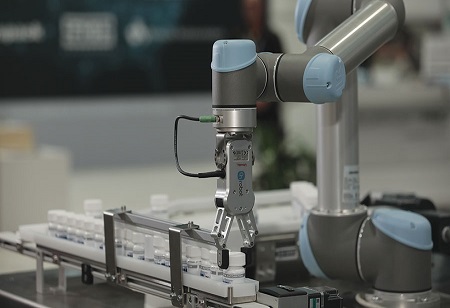Janifha Evangeline | Monday, 28 August 2023

The pharmaceutical sector is a very competitive field, and pharmaceutical firms must discover new and inventive ways to pack their medicines in order to stay ahead of the competition. Pharmaceutical firms may increase their manufacturing efficiency and preserve a competitive edge by implementing automated packaging technologies.
Many people have been terrified of the prospect of automation for many years. Although these automated technologies have immense potential, some are concerned that a reliance on automation may have negative consequences for our economy and employment. Staying ahead of the competition while guaranteeing product quality and safety is critical in the ever-changing landscape of the pharmaceutical sector. The packing process is critical in maintaining the integrity of pharmaceutical goods. Pharmaceutical firms are looking for automation solutions to address the increased demands for efficiency, flexibility, and accuracy. In this article, let us look at how we're becoming more reliant on automation and how these technologies can increase efficiency and productivity with automated pharmaceutical packaging.
High-speed manufacturing lines& faster product delivery to the market In the pharmaceutical sector, having a consistent procedure is critical for maintaining efficiency and product quality. Pharmaceutical packaging devices that are automated help to ensure that items are packed in accordance with strict standards and processes. This standardized approach not only enhances product quality but also ensures a speedy and effective manufacturing process. Automation in pharmaceutical packaging significantly enhances efficiency and throughput.
These systems can handle high-speed manufacturing lines, reducing packing time and allowing for faster product delivery to the market. As a consequence, automated filling and capping equipment can properly measure and distribute liquid medications, eliminating the dangers of manual dosage mistakes. Furthermore, automated inspection systems employ cutting-edge technology such as machine vision to detect and reject faulty products, ensuring that only high-quality products reach the market. Pharmaceutical packaging requirements change often due to product modifications, regulatory updates, and market demands. Automation improves packaging operations' flexibility and adaptability, allowing packaging professionals to respond to changes more quickly. Modern automation systems are designed to accommodate a broad variety of container sizes, shapes, and materials, making it simple to move between product lines.
Automation enables packaging professionals to respond rapidly to changing market demands by reducing changeover periods and human adjustments. Increases quality control & end-to-end traceability Pharmaceutical packaging relies heavily on quality control and traceability. Again, automation is critical in preserving and increasing these characteristics.
During the packaging process, automated devices use modern sensors and machine vision technologies to conduct real-time quality inspections. This assures correct labeling, seal integrity, and product assembly. Furthermore, automated packaging solutions integrate with track-and-trace systems, allowing for end-to-end traceability and quick recall handling if necessary. To protect patient safety, the pharmaceutical business is subject to severe laws and compliance standards. To assist businesses in meeting these criteria successfully, automated systems can be programmed to enforce regulatory compliance, such as serialization and tamper-evident packaging. Pharmaceutical businesses can increase accuracy, decrease errors, and streamline audits by automating the documentation process, which includes batch records and compliance reports. Modern automation systems are designed to accommodate a broad variety of container sizes, shapes, and materials, making it simple to move between product lines. Automation enables packaging professionals to respond rapidly to changing market demands by reducing changeover periods and human adjustments. Pharmaceutical packaging needs frequently alter as a result of product changes, regulatory updates, and market demands. Automation adds flexibility and adaptability to packaging processes, allowing packaging specialists to adjust to changes more efficiently.
Aids professionals to concentrate on vital tasks The introduction of automation in pharma packing processes is causing a paradigm change in the pharmaceutical sector. Companies may improve packing efficiency, flexibility, and accuracy by embracing sophisticated technology. Automation improves operational efficiency, enhances throughput, assures regulatory compliance, and frees up packaging specialists to focus on value-added activities. As the business evolves, incorporating automation in pharmaceutical packaging is critical to staying ahead of the competition and delivering high-quality medicines to patients globally. Pharmaceutical companies benefit from automated pharmaceutical packaging equipment in a variety of ways, including higher production efficiency, improved product quality, and improved product serialization and traceability. These machines aid in the proper and safe packaging of pharmaceutical items in accordance with strict regulations and procedures. Pharmaceutical packaging machines that are automated are an important aspect of the pharmaceutical business and play an important role in maintaining the safety of pharmaceutical products.